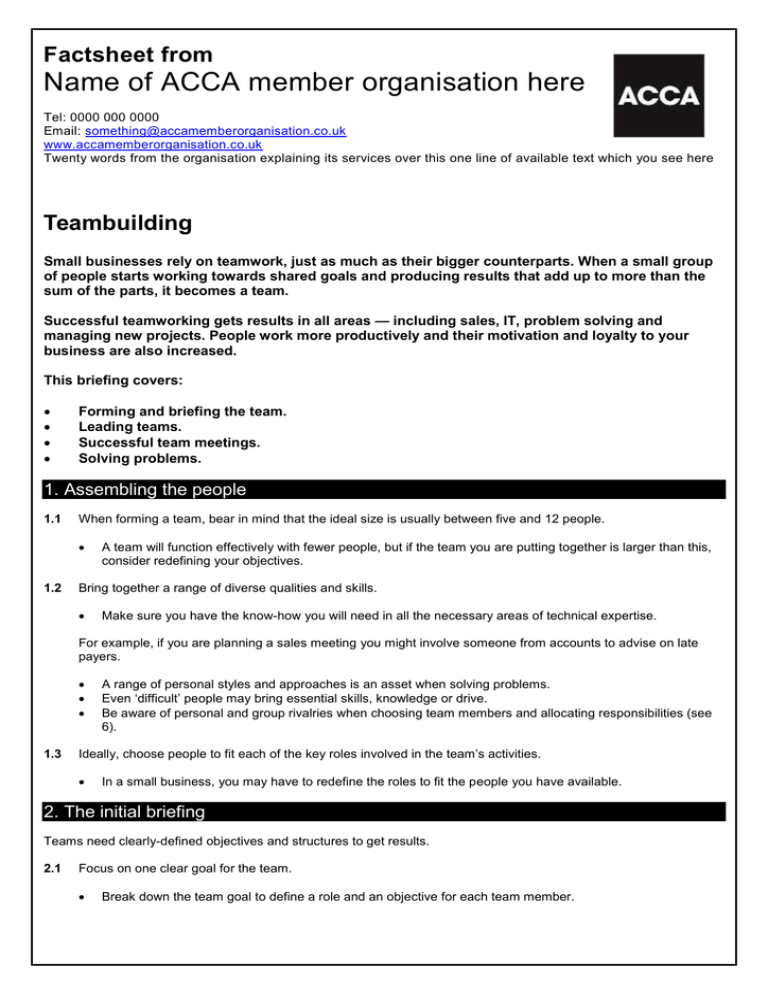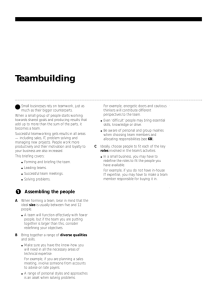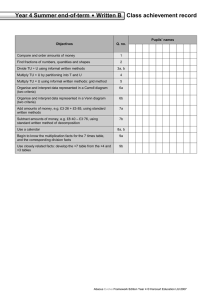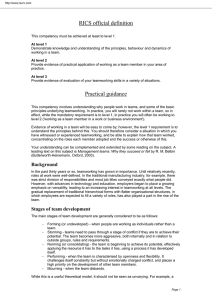
Factsheet from
Name of ACCA member organisation here
Tel: 0000 000 0000
Email: something@accamemberorganisation.co.uk
www.accamemberorganisation.co.uk
Twenty words from the organisation explaining its services over this one line of available text which you see here
Teambuilding
Small businesses rely on teamwork, just as much as their bigger counterparts. When a small group
of people starts working towards shared goals and producing results that add up to more than the
sum of the parts, it becomes a team.
Successful teamworking gets results in all areas — including sales, IT, problem solving and
managing new projects. People work more productively and their motivation and loyalty to your
business are also increased.
This briefing covers:
Forming and briefing the team.
Leading teams.
Successful team meetings.
Solving problems.
1. Assembling the people
1.1
When forming a team, bear in mind that the ideal size is usually between five and 12 people.
1.2
A team will function effectively with fewer people, but if the team you are putting together is larger than this,
consider redefining your objectives.
Bring together a range of diverse qualities and skills.
Make sure you have the know-how you will need in all the necessary areas of technical expertise.
For example, if you are planning a sales meeting you might involve someone from accounts to advise on late
payers.
1.3
A range of personal styles and approaches is an asset when solving problems.
Even ‘difficult’ people may bring essential skills, knowledge or drive.
Be aware of personal and group rivalries when choosing team members and allocating responsibilities (see
6).
Ideally, choose people to fit each of the key roles involved in the team’s activities.
In a small business, you may have to redefine the roles to fit the people you have available.
2. The initial briefing
Teams need clearly-defined objectives and structures to get results.
2.1
Focus on one clear goal for the team.
Break down the team goal to define a role and an objective for each team member.
For example, if the goal is to manage a move to new premises, one team member may be made responsible for
services, one for handling the IT aspects and one for purchasing furniture and equipment.
2.2
Outline how the team will operate.
2.3
Ask for people’s ideas on how the goals could be refined.
Make team members’ roles clear to themselves and others.
Avoid conflict by making sure job descriptions do not overlap or clash.
Specify how functions within the team will interrelate. Explain the chain of command.
Discuss and agree what methods will be used for decision making, problem solving and running meetings.
Explain that individual performance will be reviewed in regular team meetings and through random quality
checks.
Agree how you will resolve day-to-day problems and disagreements in the team.
If one team member is unhappy with another, he or she should discuss the matter with the person
concerned.
If that does not work, the problem should be brought to the team leader.
This avoids the ‘moaning culture’, where people complain to each other but do nothing to help solve the
problems.
3. Leading the team
Leading teams is an art. But the basic skills of leadership can be learnt.
3.1
Successful leaders organise and enable.
Make sure your objectives for the team are SMART — specific, measurable, agreed, realistic and timelimited.
Provide appropriate resources for the team to do its job. For example, adequate equipment and working
space.
Delegate tasks and make sure they are carried out and quality controlled.
Draw up flexible contingency plans so you can deal with things when they go wrong.
For example, make sure another team member can deputise if a colleague is ill on the day of a critical sales
presentation.
3.2
Leaders motivate and give their teams energy.
3.3
Review the performance of the team itself.
3.4
Be enthusiastic about the team’s objectives and the likelihood of success.
Praise team members’ achievements generously and promptly.
Celebrate and publicise achievements. For example, if a team successfully launches a new product,
congratulate the people involved at your company meeting and tell other employees via email.
Ask team members for their opinions and explain the thinking behind your decisions.
Lead by example. Show that you keep your word and that you support team rules and procedures.
Hold reviews regularly.
Keep the tone of reviews positive.
Discuss how the team is organised. For example, could one member of the team be doing something
differently to improve the team’s effectiveness?
Review the team’s objectives.
Do they need modifying?
2
3.5
What extra resources might be required?
The team leader takes final responsibility for the team’s success or failure.
Be prepared to be disliked.
Leaders must sometimes risk being unpopular by identifying poor performance and taking decisions some team
members will disagree with.
3.6
Be ready to make the final decision.
Leaders must be prepared to act as counsellors.
Develop your listening skills.
Make it clear that your door is open to anyone who wants to discuss aspects of the team’s work.
Maintain confidentiality when team members come to you with problems.
Do not let individuals undermine the team by lobbying for changes in private.
4. Making meetings productive
4.1
Ensure meetings are well organised.
Hold meetings regularly and often. Teams that meet frequently take less time to gel.
Keep the purpose of each meeting clear.
4.2
Brief team members in preparation for particular or unusual stages of a project.
Circulate agendas in good time.
Keep meetings short, and start and finish on time.
Use team briefings to keep everyone informed of relevant developments (eg changes in technology).
Get the whole team’s involvement.
During discussion, invite contributions from each member of the team.
Avoid using leading questions. Ask ‘How can we increase our margins?’, rather than ‘Are we going to have to
raise our prices to increase margins?’
After discussing each point, assign responsibility to an individual, for completion by a certain date.
Make sure action points are understood and agreed by those concerned.
4.3
At the end of each meeting, review what has been covered and check all team members are happy with the
outcome.
Follow up after each meeting.
Circulate minutes no later than two days afterwards.
Review progress on all actions at the next meeting.
5. Developing team spirit
5.1
Establish a team culture in which people feel valued.
Get to know individual team members’ skills and goals and consider these when allocating tasks.
Enthusiasm for a job leads to effectiveness.
3
Avoid favouritism.
Encourage contributions from all members of the team, regardless of position or seniority.
5.2
Make working as part of the team rewarding.
Provide support and training to help all team members develop.
Give team members opportunities to learn from each other.
For example, ask a long-term employee who has a good understanding of the business to work with a newer
employee who has good IT skills.
Find out what motivates team members and reward them accordingly (eg with money, time off or more
responsibility).
Make rewards prompt and appropriate.
5.3
Give team members opportunities to relax together.
Organise and take part in social events, such as team meals.
6. Dealing with problems
6.1
Friction between team members leads to wasted energy and poor productivity.
6.2
If personal criticism crops up in meetings, refocus the discussion by asking what needs to be done, not who
is at fault.
If necessary, clarify job descriptions and reporting lines within the team.
Where possible, allow distance between team members who do not get on.
Discuss personal conflicts between members privately with each party — and ask each of them to propose a
solution.
If one member is at odds with the others and cannot function happily within the team, be ready to say
goodbye.
Rivalries may develop between teams within a business.
You may need to go out of your way to reinforce the idea that you are all on the same side.
6.3
Invite members of other teams to attend your meetings.
Set up mixed-team task groups to solve the problems teams have in common.
Ask other teams to tell you what your team does that helps them, and what you could do differently to help
more.
Organise teambuilding activities where members of different teams are mixed together.
Include members of other teams in some of your social activities.
It may become clear that the team is making bad decisions.
Be ready to hold spontaneous reviews if a problem arises.
If a poor decision has been made, analyse the decision-making process.
For example, was everyone consulted and did everyone really agree to the plan?
Examine who influenced the group, and why.
6.4
Ask what the team can learn that will help it avoid making similar mistakes in the future.
The team may collectively underperform, delivering less than you would expect from the people involved.
Begin by gaining the whole team’s acceptance that all is not well.
4
You cannot begin to change the situation if some team members are in denial and insisting that nothing is wrong.
Get a trusted ‘outsider’ to sit in on meetings and comment frankly on the team at work.
This person might be a senior member of the business, or a representative of another related team.
Maintain the discipline of assigning actions to individuals and making sure actions are reviewed on the
agreed date.
Organise a meeting specifically to re-motivate the team.
Review team goals and recognise successes to date, reinforcing pride in the team’s positive achievements.
6.5
Towards the end of its life, a project team may start to feel demotivated.
Arrange a formal ending that team members can look forward to.
This might be a party for team members, an official launch, or high-profile internal publicity within the business
about the achievement of the team’s objectives.
Get the team to discuss and draft a press release for publication in relevant trade magazines or local papers.
Sharing out the leadership
In the most successful teams, leadership is shared by all team members. For this to work, traditional leaders have to
learn to let go.
A.
Team members can take on leadership when leaders hand over control.
B.
In meetings, encourage input from all team members.
Give team members the authority and resources they need to perform.
Admit it if you are wrong, or if you do not know the answer. This is a positive chance for the team to work
together to reach a solution.
Effective communication promotes teamworking.
When work is being shared out, it is important that people are given clear instructions, especially for new or
complex tasks.
Team members do not need to be told how to do familiar jobs.
The team lifecycle
A.
In its early stages, a team needs direction.
The team leader must lead discussion and take the lead in making decisions about team objectives and
strategies.
Part of the job is to draw out ideas from team members who may be hesitant at first about contributing.
B.
As the team develops, differences of opinion may arise as members offer diverse points of view.
C.
The leader must pick out the best suggestions and keep the direction of the discussion positive.
Once a team is established, collaboration is the hallmark of a successful unit.
The leader can step back and let the team develop many of its own solutions.
It is still important to be available as a mediator in the event of conflict or uncertainty — and to take or confirm
major strategic decisions.
5
Encourage team members to share information freely and flexibly, to allow them to perform well.
Experts’ quotes
“People participate in teams to varying degrees and in their own way. Be wary of forcing people to 'go bowling' after
work. Many people have commitments outside the workplace which you should respect.”
Shawn O'Rourke,
Blue Fox Consulting
“Some conflict in a team is inevitable. In fact, it is usual at times of great creativity. Do not let it fester. Deal with it
promptly. The improved productivity of the team will more than justify your efforts.”
Peter Neall,
Neall Scott Partnership training consultants
Expert contributors
Thanks to Shawn O'Rourke (Blue Fox Consulting, 07775 765883).
Last reviewed 01.02.12
© BHP Information Solutions 2012. ISSN 1369-1996. All rights reserved. No part of this publication may be reproduced or transmitted without the
written permission of the publisher. This publication is for general guidance only. The publisher, expert contributors and distributor disclaim all liability
for any errors or omissions. Consult your local business support organisation or your professional adviser for help and advice.
6






